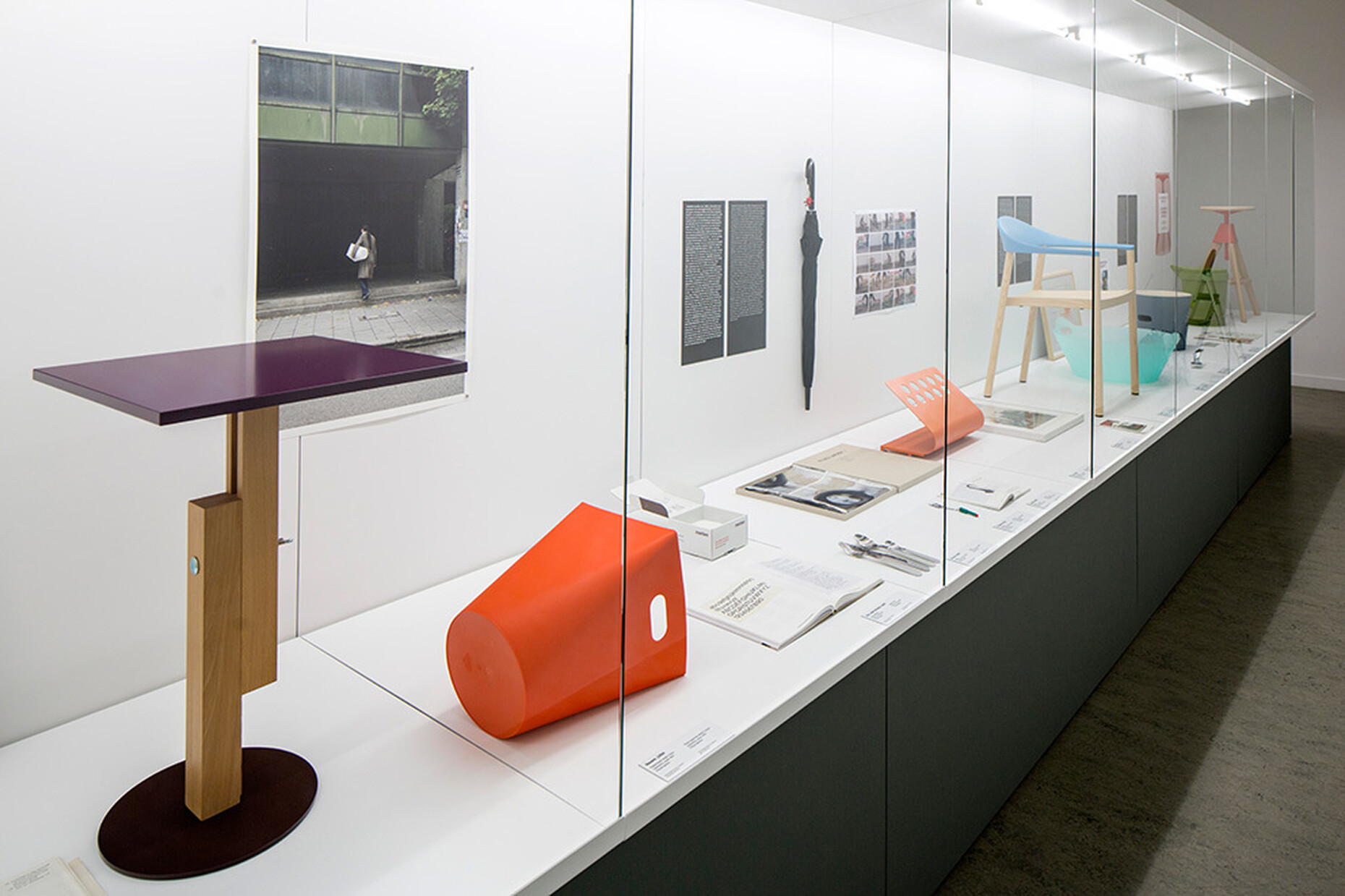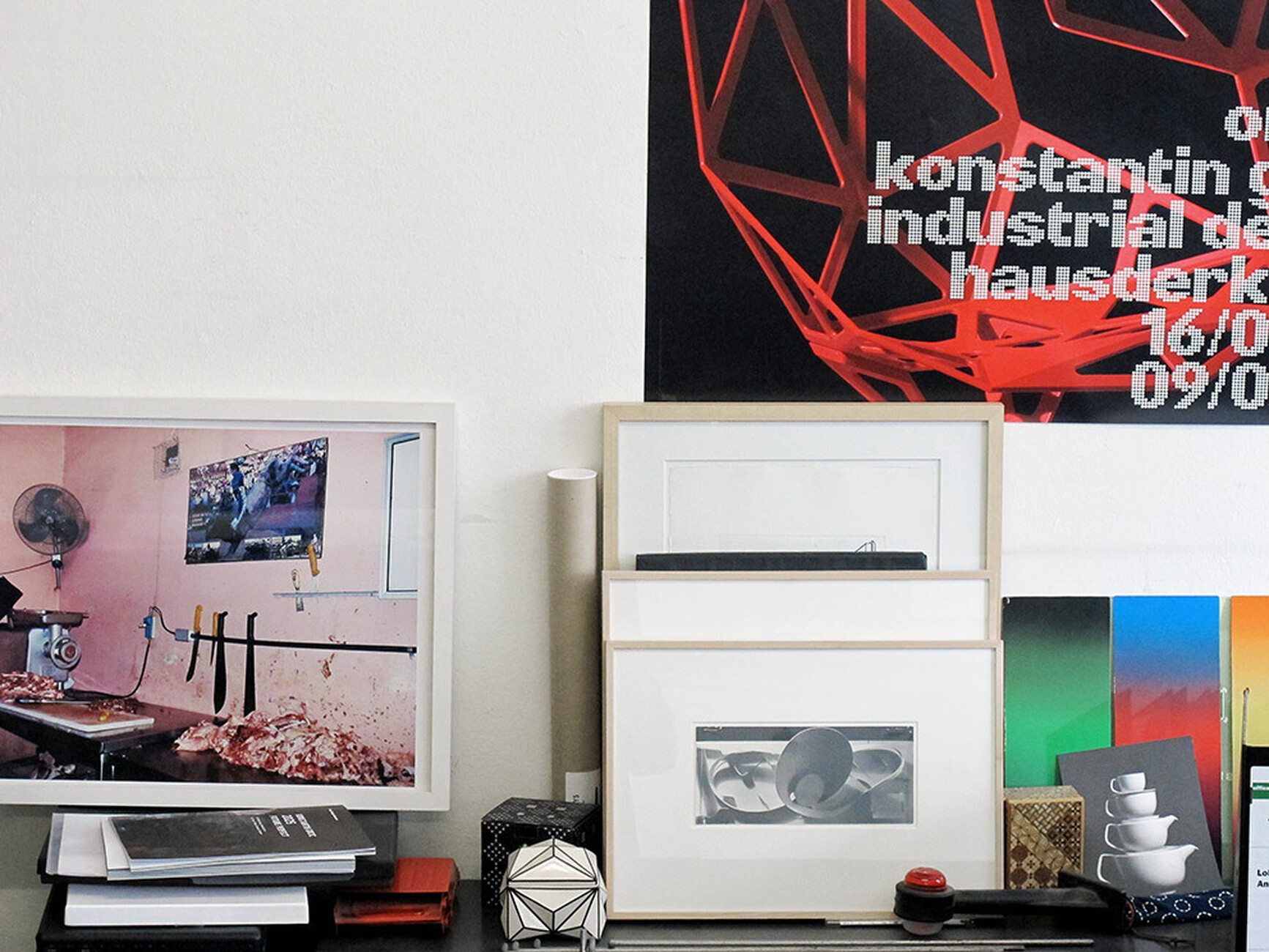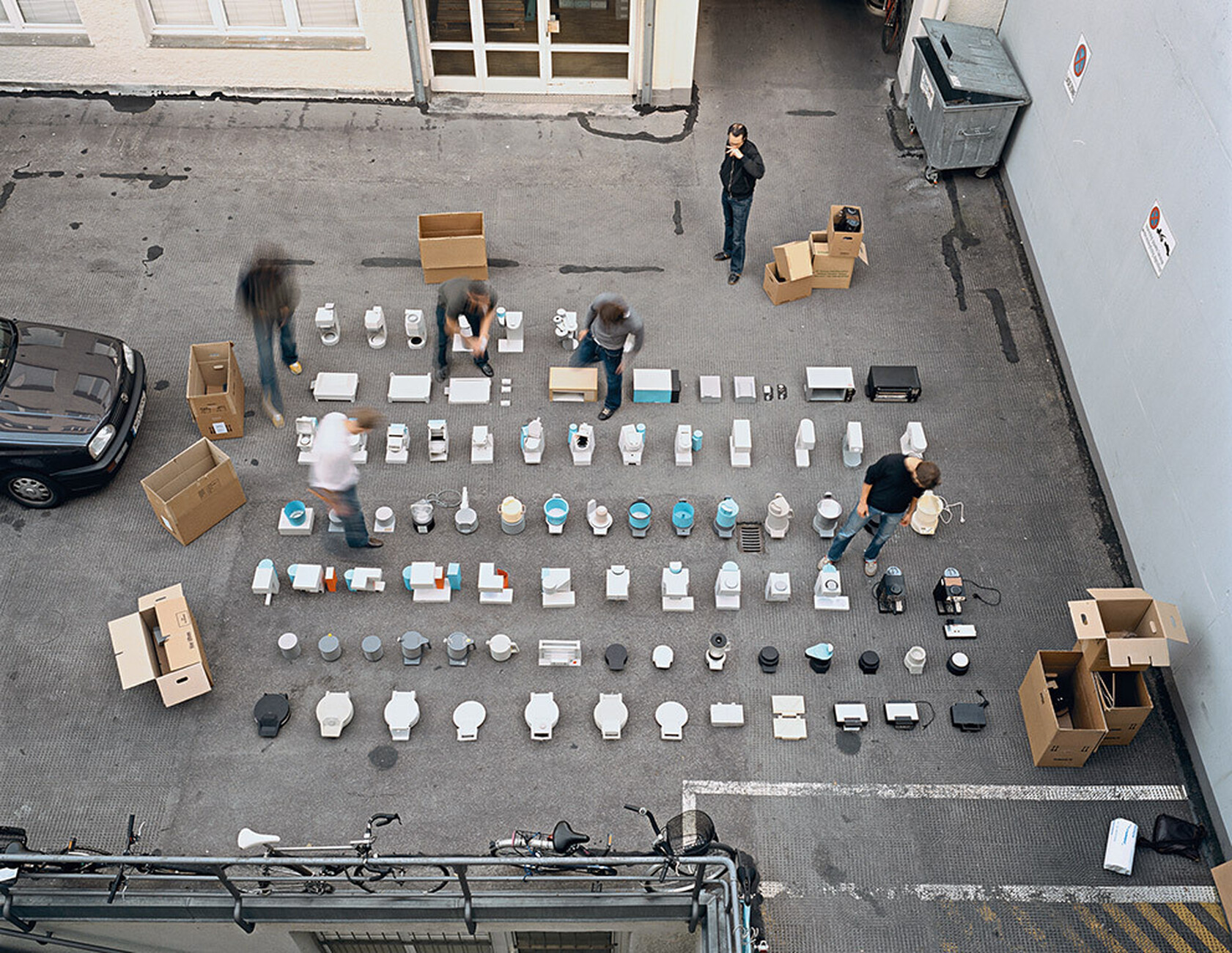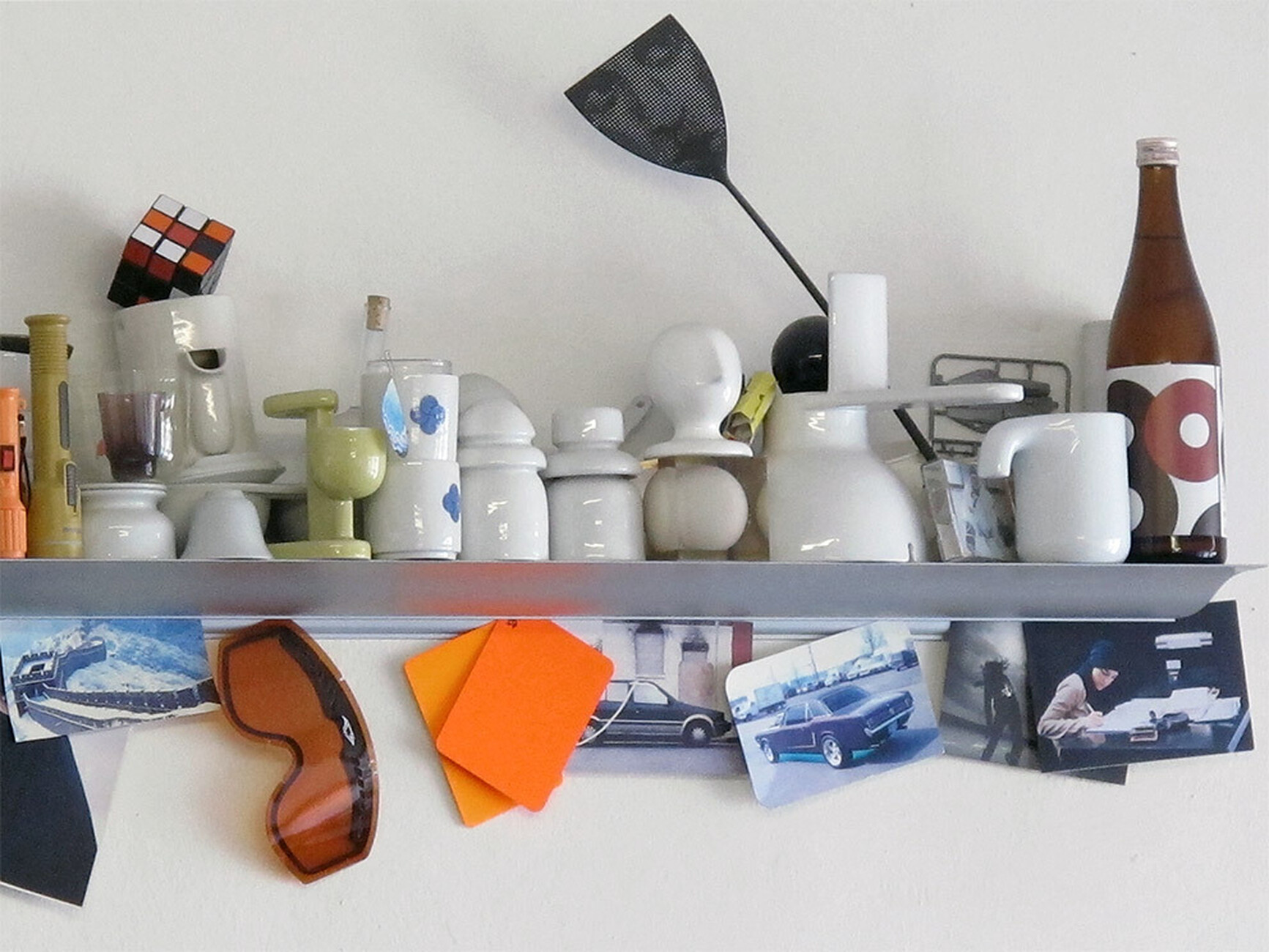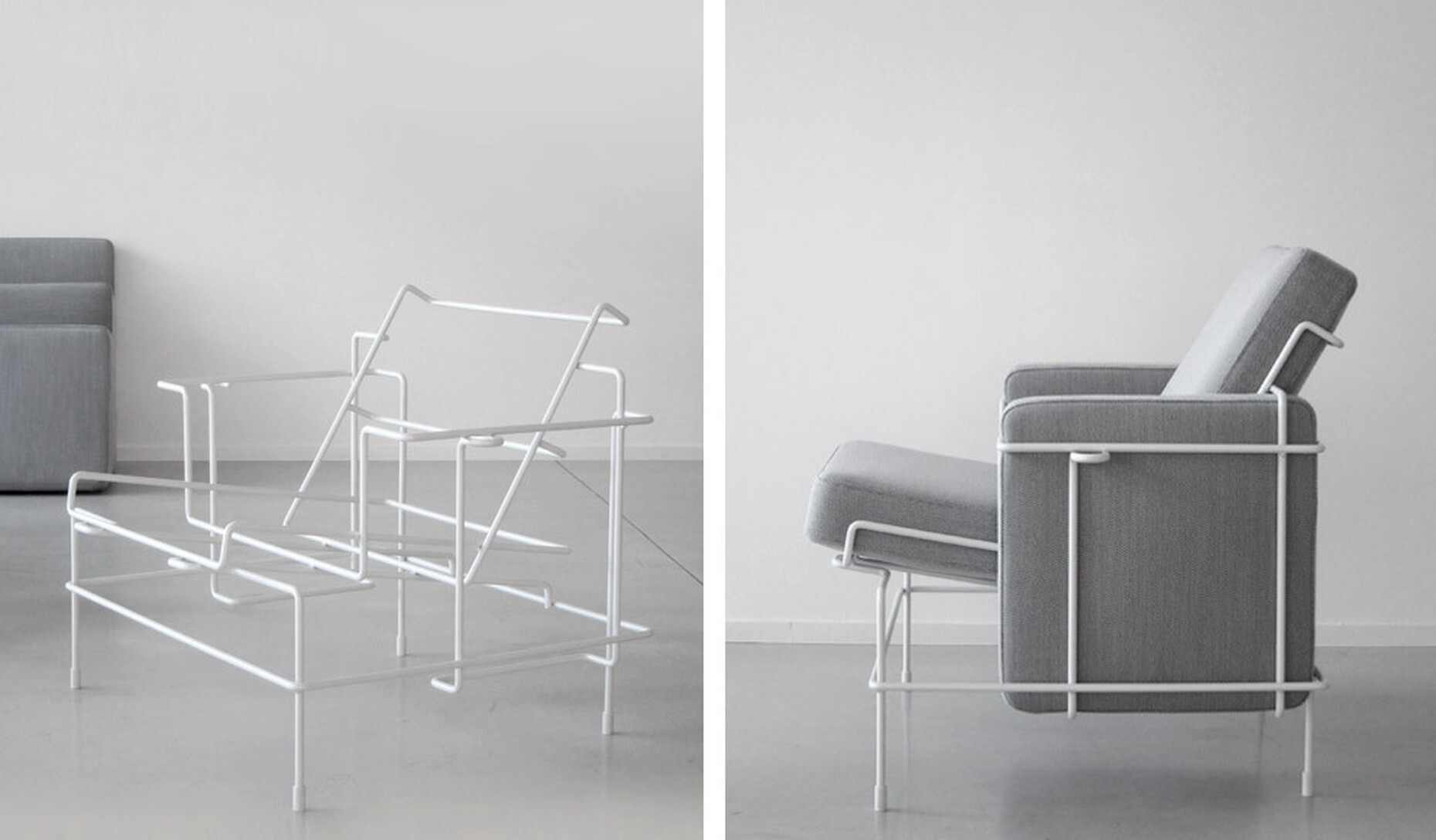Stylepark-Special: Retrospective: Konstantin Grcic in conversation – part 3
Industry is not a dinosaur
Thomas Wagner: Do some of your designs contain elements of irony? For example, emulating the steep curve of the racetrack at Monza on a chair’s backrest?
Konstantin Grcic: Irony is important in the design process because the work itself is so serious and can be incredibly dry. That’s why it’s great to include an element of irony as you work. As a statement it can be an aspect in the finished product – and then I like it. But it’s not important. It is nothing I consciously employ. An item of furniture doesn’t have to be ironic or even funny. People occasionally say my designs are humorous. Mind you, it’s better than for people to say: “Gosh, the stuff he does is so serious.” Yet I don’t aspire to this, just as I don’t aspire to provoke with what I do or regard my output as complicated, which is occasionally said about it, too.
Which designs are regarded as complicated? Chair One?
Konstantin Grcic: Yes, for example. What I wanted to achieve with this design, what I intended this chair to be, guided me precisely to where I wanted to get, in a logical and conscious process and with the best of intentions. For me, Chair One was an answer to all the questions I was asking at that time. For me this chair is not a provocation – on the contrary.
And why did some people perceive it as being provocative?
Konstantin Grcic: Well, they said: “Now he expects us to sit on this grill thing.” Or this kind of lattice structure. I on the other hand say: The chair is conceived for the outdoors, so it’s better to sit on a lattice, it contains less material so it’s less dirty. In the summer it doesn’t get hot and in the winter it doesn’t get cold, it doesn’t collect any rainwater. It was all very
clear to me. And of course ultimately it is a shape I wanted to add to the urban space as I see it. If you take an ordinary chair outside it looks pretty silly – against the backdrop of an urban façade. Which is why I wanted to design a certain image. A chair is a chair is a chair, given its proportions and size, etc. Yet how can it be designed to hold its own in the urban space and against this backdrop? Against buildings, against the asphalt – or rather: not against but with. These are the kind of things I wanted to address.
Was the “Wanda” dishwasher still meant as an homage to Duchamp and his bottle rack? Is Konstantin Grcic revealing his playful side here?
Konstantin Grcic: Yes, of course that’s playful. I’m familiar with the shape of Duchamp’s bottle rack. And then there was this project of doing a drying shelf. And so I took it from there and things began to evolve, as a derivation or a citation. I rarely do this, however. And it’s not Duchamp I am referencing here but the bottle rack he took. And it wasn’t so much about citing Duchamp, the artist. That would be too pretentious.
There is something cinematic about the way in which you conceived the Object Space. You didn’t simply line up a sequence of objects but you created sensuous associations, scenes and short narratives. Suddenly there appears a yellow Reclam edition, and the yellow enters into a liaison with the chair by Enzo Mari. Did you want to create various references on different levels of perception?
Konstantin Grcic: The narrative I am suggesting is not set in stone. I could easily have selected other items that would have told a very different story. In the spirit of the Panorama I wanted to demonstrate ways in which to perceive my work, how I myself perceive my work. Of course I guide the visitor – lead him slightly astray or manipulate him. But as I said, I could have told a very different story just as easily. The story I did not want tell is one that is purely didactic or chronological.
And neither was it intended to be a collection of trophies?
Konstantin Grcic: No, not trophies! True to the motto: And then I did this, and then I did that. I wanted to mix things because it’s important for me that they are all associated in one way or another – intentionally, unintentionally, playfully. It’s a cosmos in which I live. Or rather: from which I take my inspiration. In a sense my office is this cosmos, and most of the things I present in the display cases are things I like to be surrounded by, I need to have around me in order to work, which have always been important to me and are very personal.
You are not showing us an archive. There is no structured system to your display. Could it be a kind of treasure trove that you turn to for inspiration time and again?
Konstantin Grcic: Yes, a treasure trove describes it well. I am not a collector, and we only have a kind of archive in the office because it’s important to keep certain things in order. Personally I prefer the idea of the treasure trove because you simply keep things there, but without structuring them. And I can’t even say why I keep them there and what it means.
Is this treasure trove also a workspace ...
Konstantin Grcic: Yes, as a room for ideas ...
... that plays a role in the work process?
Konstantin Grcic: Sure, the treasure trove plays a significant role. At the same time it must never turn into a tool I can use consciously. The energy or excitement, the beauty and that which I have to try and safeguard in this treasure trove – all this stays in the background. For me it has to remain just that: a treasure trove from which I can retrieve items I had forgotten about. I don’t even know all the things that are in there.
Would they lose their magic if you used them strategically?
Konstantin Grcic: Yes, they would. That’s the downside to agencies, they set up their databases such that their employees will produce the right things at the right time. For me, on the other hand, all these things have to remain locked away, underground, concealed. And my memory works well enough to remember things. I guess you call it inspiration if suddenly something pops up and sparks ideas, the synapses start firing. You produce something you had placed in this treasure trove, but it’s not like it can be readily retrieved the way it would from a toolbox.
Paraphrasing from the Bible, Kafka once noted: “He who seeks shall not find. He who does not seek shall be found.” Is this how inspiration works for you?
Konstantin Grcic: That’s right, being found is much nicer! But finding is okay too. Both are possible, there is something to be said for each of them. And yet both models are problematic as soon as you begin to expect you will find something as you work. Much of the creative process is about how you treat yourself and how you manage to avoid making the same mistakes over and over again. I’m a designer and it’s not like I simply create something. I’m not full of ideas. I get ideas when I start working on a project, an assignment. That’s why I’m a designer and not an artist. I need to have an assignment set, that is crucial to my work.
Many other differences set aside, years ago I asked some young artists if they still believed they could hold their own against extensive teams of designers and their expertise and if it wasn’t high time that artists too began to work together in groups. How do you see the relationship between designers and artists?
Konstantin Grcic: It’s interesting you approach the issue from this angle. My impression is: Are we as designers still able to compete with artists? At least with those artists who are in a league of their own financially.
Olafur Eliasson Industries for example?
Konstantin Grcic: Eliasson, yes. Artists like him have abundant possibilities that we can only dream about. I have myself experienced how things get mixed up. All of a sudden I found myself competing with an artist for the same project! I am not on a par with those artists, the way they have established themselves, able to rely on the support of a gallerist etc.
We are talking here about two or three percent of all artists.
Konstantin Grcic: Let’s compare things this way. I know the reality of paying those who work for me and make a living. People like Eliasson certainly have their own problems, but things work on a different scale compared to manufacturer and client, which is my setup. A successful artist can rely on the whole apparatus of gallery, museum and market, they all work hand in glove. We once did an exhibition in London’s Serpentine Gallery. That’s a really good example. The Serpentine Gallery is non-profit and small and brilliant, a guerilla
enterprise, and then they run an exhibition with artists who have the fat galleries behind them. Those galleries look after the organization, the financing, the program. That’s the way it is. And then I arrived and of course they assumed I had the same apparatus behind me. And then we said: “Okay, we need to outsource all those things and projects.” They couldn’t believe that we were asking them to organize all that. In the end they did a really good job, but I honestly think they were shocked at what they had to deal with all of a
sudden. That is my reality. Tobias Rehberger is another, very different example. When he was commissioned to devise the concept for the café in the Central Pavilion of the Venice
Biennial he approached me and asked if I wanted in. I thought it was really nice of him to ask. Yet I needed to know: “What is the time frame and how is the project financed?” He said: “Och, it’ll be something like this.” So I told Tobias: “No, I can’t do it, it’s just not possible. I don’t have the necessary capacities in the first place.” He went about calculating things in a completely different way – and got an excellent result.
Well, Rembrandt was a painter-cum-entrepreneur.
Konstantin Grcic: Yes, sure.
And what to you make of the argument that design is the art of the 21st century? Which is not to say that design will replace art or become art in its own right, but that it will achieve the same social status that art had in the 20th century.
Konstantin Grcic: I’m not even sure I would support the argument that design will be the art of the 21st century. Isn’t it the other way round – art is becoming the design of the 21st century? We are all familiar with those pictorial worlds in the Visual Arts, they are extremely popular. And that has an effect that extends far beyond the art scene. These images have made inroads into fashion, into products, probably even into the automotive industry. I believe design will become the player behind art, not the other way round.
So the artists get to create magnificent works and the designers are left to solve the problems behind them? Is this how you see the roles being assigned?
Konstantin Grcic: Yes, and not even in the sense of being opposed. Design does not create lasting images, but those images are important, and it’s art that creates them.
I’m somewhat skeptical about this. Today there is such massive consumption of images that even critical, complex or rebellious images simply get consumed.
Konstantin Grcic: Yes, but it’s precisely this consumerism that produces art. People never get enough, which means a lot has to be produced, which results in a certain form of art. It’s amazing. Not so long ago a museum director told me that for the first time in 30 or 40 years the major museums are turning their backs on contemporary art. If this is really happening it will change the situation considerably. Will it happen? No idea. But it shows that the art scene is overheated.
The art world still relies on originals. The global economy, by contrast, capitalizes on mass production. Is it possible that artists are making inroads into design now more than ever?
Konstantin Grcic: I’m not sure, in the industry the trend is definitely towards individualization. It is no longer the case that industrial production inevitably spells standardization – quite the opposite! No one would have thought that possible.
Including 3D printing as the next big thing?
Konstantin Grcic: What makes 3D printing so popular is that it’s digital. I recently attended a factory tour at BMW here in Munich. Looking at the production lines it became clear to me that every car assembled there is individualized. No car is the same. There are hundreds; you won’t find two identical cars out in the street any longer. The car continues to be epitome of industrial production. And yet no two BMWs are exactly the same – even if it’s just the stereo for which one customer pays more than another. It’s totally random.
So we are heading towards a culture of originals?
Konstantin Grcic: Yes, in some form. Mind you, ultimately there will not even be an original any longer, as the proto-design already contains all available variants. At our product level Chair One is available in five different colors. If I choose one of them, then the chair in that color is the original for me. I don’t know if there are any BMWs still delivered the way in which the designer who made them imagined them to be.
Ultimately, however, even the individualized car is based on a standard, albeit variable platform. So what we are talking about here is only a more refined standardization.
Konstantin Grcic: Right, it’s a construction kit made of standardized elements. I found that very exciting. As you know I champion this idea of industry, I like industrial production. You see the belt running, and yet each car is different. And because it’s a factory you soon realize that we are still a long way off from cars coming out of a 3D printer. Even a 3D printed chair is still complete nonsense. I know how for manufacturers, who are experts in making wooden chairs, it’s a huge challenge to glue two pieces of timber together. It’s not
like we could revolutionize the whole manufacturing process overnight.
Even if we could – how would this impact on the economy? Do we appreciate that entire industries would collapse? Possible for a cheap but poor alternative.
Konstantin Grcic: I wouldn’t even go that far. It’s not like 3D printers will be able to replace factories, but they will create new possibilities. I’m not sure if 3D-printed parts are already used in the production of cars, they definitely are in the aviation industry. It’s not like these things are for home use only and the industry had nothing to do with it.
Sure, digital production is very interesting for the industry.
Konstantin Grcic: Maybe there will be copy shops where you can get things printed in a very high quality. I believe the industry will remain relevant and important. As for me, I very much look to industrial culture for inspiration, I get a lot out of working closely with the industry and wishing to understand how it works. The industry is not a dinosaur. There are still very exciting things happening there. Even at the small companies, which I mentioned earlier and which I know well, people have understood how industrial processes work or
can work, or when things stop working and how production needs to change. Talking about a product for a particular use and for a particular user we must not forget that the industry as the producer is the user of my design. The company has to be able to produce it. One function of good design is: It can be produced, stored and packaged. In some cases you include the option that the manufacturer can recall, repair or recycle the product, whatever. We deal with all of these applications and functions, sometimes less, and sometimes more. They too impact on the design and describe the reality of products.
At the same time, in your output you like to make reference to design history favorites. For example, you named a stool after the most adorable super sports car ever: Miura. Is it your enthusiasm for such things that influences and sustains you?
Konstantin Grcic: Yes, that’s the only thing that sustains you. At the end of the day it’s my life, it’s my job. The passion for it is what sustains me. I’m not interested in an object as a fetish. I think the Miura is great, but I can readily name ten other sports cars I like. The same holds true of music, my favorite movies, favorite artists ...
Such as?
Konstantin Grcic: I’m really bad at answering questions like this. Of course I have favorites, but they change according to the situation. I see it like this: They are favorites because I know that they might change the next moment ...
So what are your favorites right now?
Konstantin Grcic: Porsche 911, that’s still an extraordinary car for me, and the 993 of course, which is the last 911 with air-cooling. I don’t think any other car has undergone such an evolution, that’s the best thing. Of course there are better phases and those that are not so good, but I can’t think of any other car that still hinges more or less on the original design with its characteristic features.
Is design an activity that makes things better and better?
Konstantin Grcic: Of course we advance and develop things in what we do. Occasionally it’s possible to break out or skip two steps in the evolution. But fundamentally our job is to make things better, we seldom invent things. Design isn’t so much about invention. Innovation is another notion that people like to use but only rarely applies. The image I would use is that of circular motions. I like it because it describes revolving around the same thing, albeit in the sense of a spiral. Suddenly you notice you are not simply going around in circles but have returned to the same thing at a different level. In the sense you often consider things that already exist. Last year, for Flos I tried to move the Parentesi luminaire forwards, which Achille Castiglioni and Pio Manzù designed in 1970 – you might consider it the 911 among the luminaires. At the time the two of them created their own things. Years later I am now trying to continue what they did. The Parentesi was complete as it was, but I saw a possibility of advancing it. I believe we designers always seek to advance certain ideas. Recently I concentrated on picking up existing things and advancing them. Taking up your own stuff once again – now that would be fantastic. Chair One for example – not to eliminate its obvious weaknesses, but to be able to rethink the whole thing from scratch. That would be pretty exciting.
Does the same apply to your work on “Traffic”, a collection of seating furniture you designed for Magis in 2013, for which you looked to Le Corbusier for inspiration? Is it about paying homage? Or rather about readdressing old principles and revising them from today’s perspective?
Konstantin Grcic: Right. These principles are absolutes in terms of the value. The idea – and I’m not sure if it’s Le Corbusier’s or if it was simply being floated at the time – that a sofa is a kind of basket or housing or box that you then fill with cushions – these ideas are so brilliant it would be a pity to abandon them to historical archives. You need to have the courage to address them once gain in an effort to top which is an excellent idea in itself. And doing that is not a taboo, there isn’t a rule that says: “You must not touch the classics.”
Konstantin Grcic – Panorama
through May 24, 2015
Z 33 House for Contemporary Art
Zuivelmarkt 33
3500 Hasselt / Belgium




